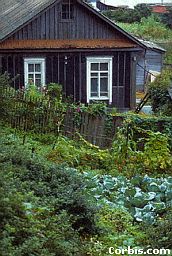
Platanus occidentalis---sycamore |
Peter Kalm (1716-1779) a Finnish pupil of Linnaeus who was sent to America in 1748-49 by the Swedish Royal Academy to study plants stated that the sycamore was "planted about the houses and in gardens to afford a pleasant shade." Thomas Jefferson wrote that he would "read, write, and receive company" under the sycamores at Monticello. |
| What
is a colonial garden?
Defining the time period during which colonial garden
styles existed is much easier than defining a colonial garden itself. Colonial
garden styles, like the colonists themselves, varied greatly. Usually garden
styles were planned according to the lifestyles of the colonists. Thus
the occupation and income level of the owner determined what form and function
the garden would take. By separating these early Americans into three categories--rural
New England, merchants and townsmen, and wealthy landowners, the different
styles of colonial gardens can be more easily dicussed.
Colonial gardens of rural New England
|
|
 The
colonial gardens of rural New England were strictly utilitarian in nature
and the size depended on how large the family was. These gardens were situated
around the house and surrounding buildings such as coops and hayracks.
Vegetables such as carrots, radishes, cabbages, and onions were grown near
the house in fenced-in areas or in raised beds, a practice common in Europe
at the time. Beans and pumpkins, along with other vegetables needed in
large quantities were planted away from the house in the fields. Herbs
were planted within the vegetables and were used for cooking, medicinal
purposes, and for fragrance. On rare occasions native woodland flowers
were transplanted into the garden for aesthetics but mainly flowers were
planted for food, fragrance, or medicinal purposes. Paths were constructed
out of gravel, crushed clam shells, or just compacted soil. These walkways
linked the house to the gardens and surrounding buildings and were of no
distinct design.
The
colonial gardens of rural New England were strictly utilitarian in nature
and the size depended on how large the family was. These gardens were situated
around the house and surrounding buildings such as coops and hayracks.
Vegetables such as carrots, radishes, cabbages, and onions were grown near
the house in fenced-in areas or in raised beds, a practice common in Europe
at the time. Beans and pumpkins, along with other vegetables needed in
large quantities were planted away from the house in the fields. Herbs
were planted within the vegetables and were used for cooking, medicinal
purposes, and for fragrance. On rare occasions native woodland flowers
were transplanted into the garden for aesthetics but mainly flowers were
planted for food, fragrance, or medicinal purposes. Paths were constructed
out of gravel, crushed clam shells, or just compacted soil. These walkways
linked the house to the gardens and surrounding buildings and were of no
distinct design.